Deserts are some of the harshest environments on Earth. Most get little rainfall, and when they do, rains can be so severe that they cause flash floods. Few creatures live in the desert, but for those few who do, they have to watch out for one thing: snakes that live in the desert.
Desert-dwelling snakes inhabit every desert on Earth. From the Australian outback to the desert southwest in North America, you can be sure to find at least one species of potentially dangerous snake. Unlike mammals, snakes need little water to survive, and they’re uniquely adapted to life in the desert.
Let’s take a closer look at ten of the most interesting snakes that live in the desert.
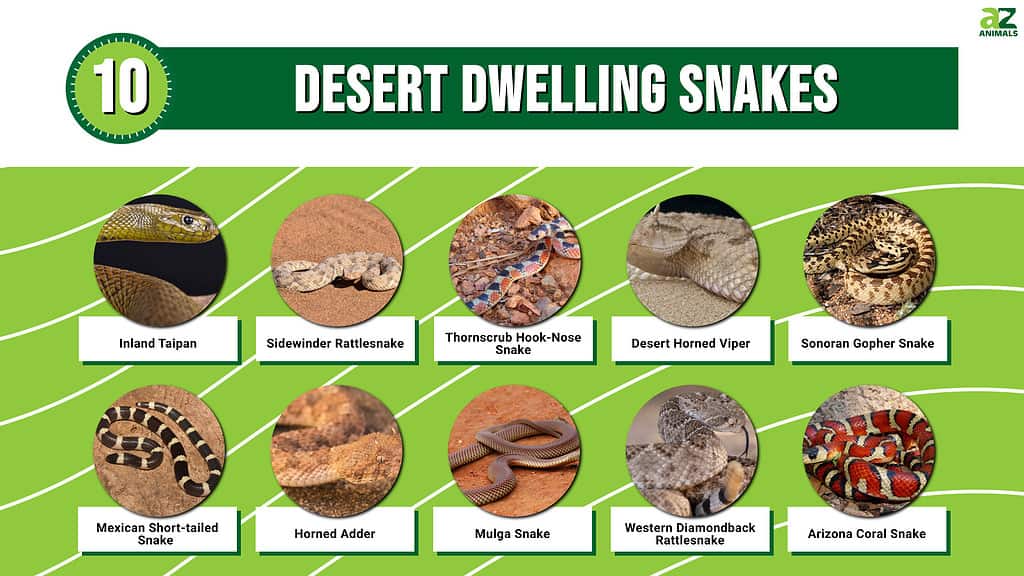
10. Arizona Coral Snake
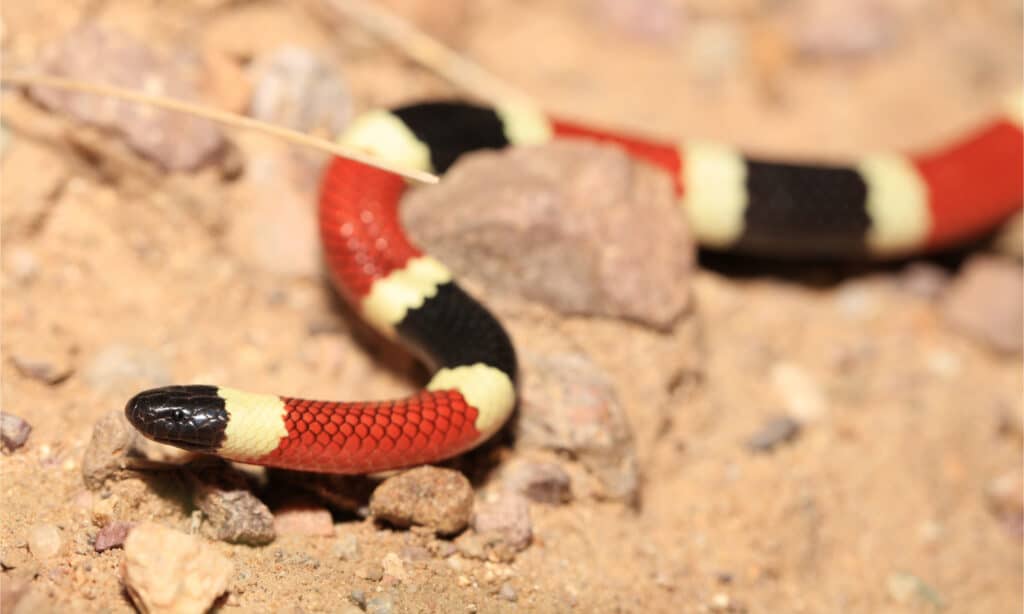
The bands of color on an Arizona coral snake, also known as Western coral snake, start and end with black
©Alexander Wong/Shutterstock.com
The Arizona coral snake is one of the most distinctly colored snakes that live in the desert. They grow to a maximum length of two feet and have brightly colored bands of red, black, and cream marking their bodies.
These snakes live in the desert southwest regions of Arizona, New Mexico, and Mexico. Their diet consists mostly of other snakes and lizards. Though small, they have potent venom, and bites require a trip to the hospital.
9. Western Diamondback Rattlesnake

The western diamondback
rattlesnake
(
Crotalus atrox) is also known as the diamondback or rattler.
©Alexander Wong/Shutterstock.com
Western diamondback rattlesnakes grow to an average length of five feet but can reach up to seven feet. They have triangular heads, large fangs, and rattles on the tips of their tails. Their bodies are light brown with diamond-like markings and white and black splotches on their tails.
The western diamondback rattlesnake is one of the deadliest snakes in North America. They’re pit vipers and can not only sense heat but deliver a deadly bite that can kill if left untreated. They live throughout the southwestern United States and northern Mexico.
8. Mulga Snake

The mulga snake (
Pseudechis australis), also known as the common king brown snake, lives across Australia.
©Ken Griffiths/Shutterstock.com
One of the most deadly snakes that live in the desert, the mulga snake, can grow to nearly ten feet long. They’re all over brown, with lighter undersides and round, red eyes. Males grow much larger than females.
Mulga snakes live across Australia and can be found both inland and along the coasts. They primarily feed on small mammals, reptiles, amphibians, birds, and bird eggs. They’re highly venomous and are known to “chew” on their victims as they envenomate them.
7. Horned Adder

The biggest horned adder grows up to two feet.
©/Shutterstock.com
Horned adder snakes live in the deserts of southwestern Africa. They’re very small, with the biggest growing to nearly two feet. They have tan-colored bodies with darker brown markings and triangular heads complete with long fangs.
Though they’re venomous, bites are extremely rare.
6. Mexican Short-tailed Snake
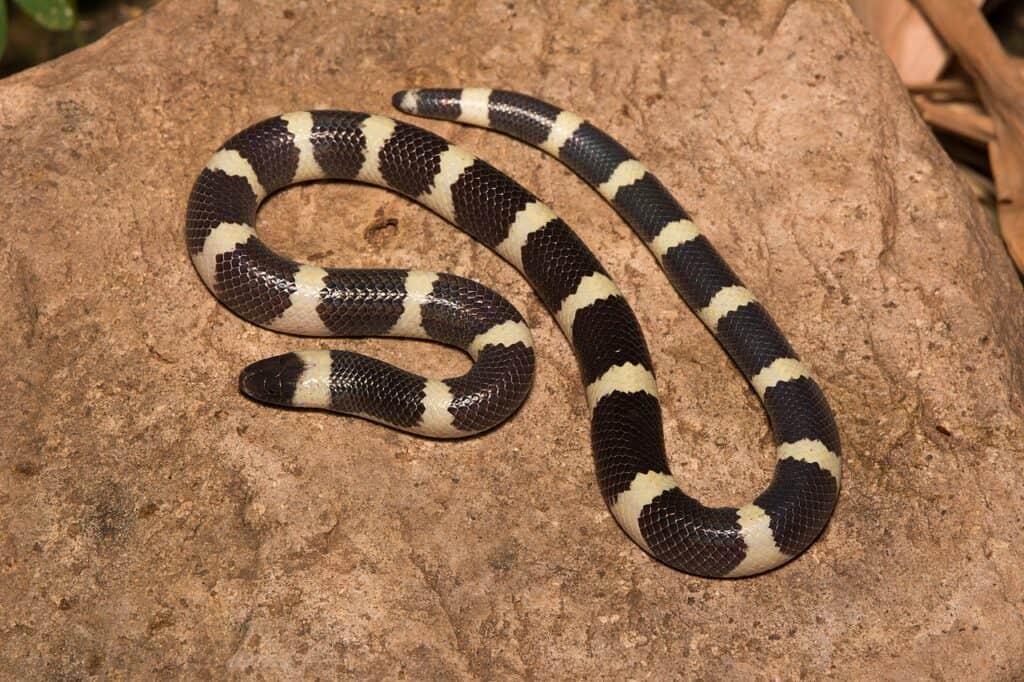
The Mexican short-tailed snake (
Sympholis lippiens) is a rare and little-known species of desert snake.
©Andrew DuBois / Creative Commons – License
These short snakes are some of the least known of all snakes that live in the desert. They’re found only in the deserts of Mexico. They grow to a maximum length of 20 inches and have thick bodies with short tail sections. Their bodies are characterized by alternating black and creme bands.
5. Sonoran Gopher Snake
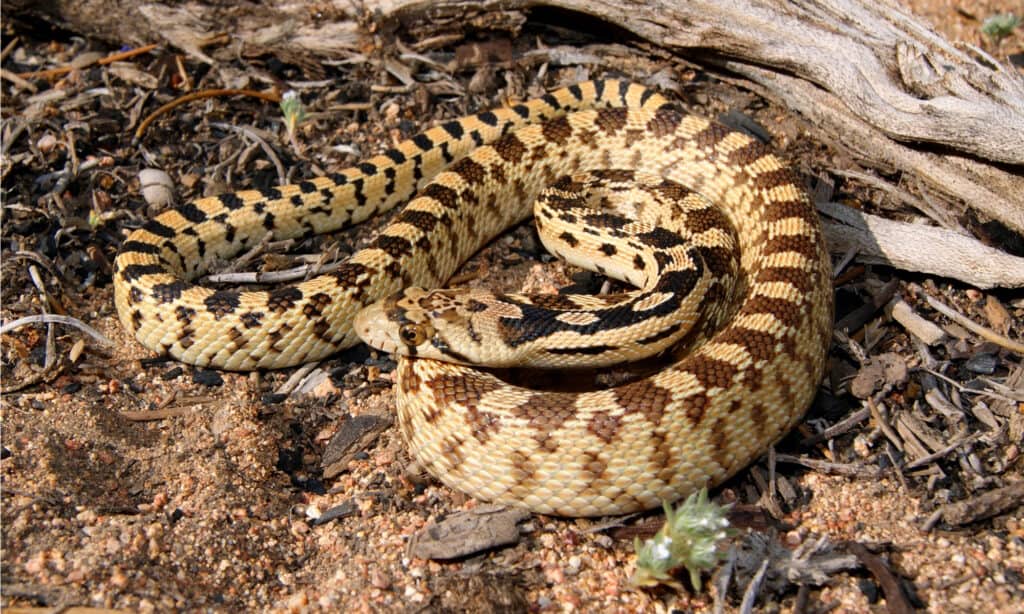
The Sonoran gopher snake (
Pituophis catenifer affinis), also known as the gopher snake, looks like a rattlesnake.
©Matt Jeppson/Shutterstock.com
The Sonoran gopher snake is a type of desert-dwelling gopher snake native to the southwestern United States. They can grow up to six feet long and bear a striking resemblance to the much more dangerous rattlesnake. Unfortunately, this leads to many Sonoran gopher snakes being killed by fearful humans. They have distinct diamond-like markings along their bodies but lack rattles.
4. Desert Horned Viper
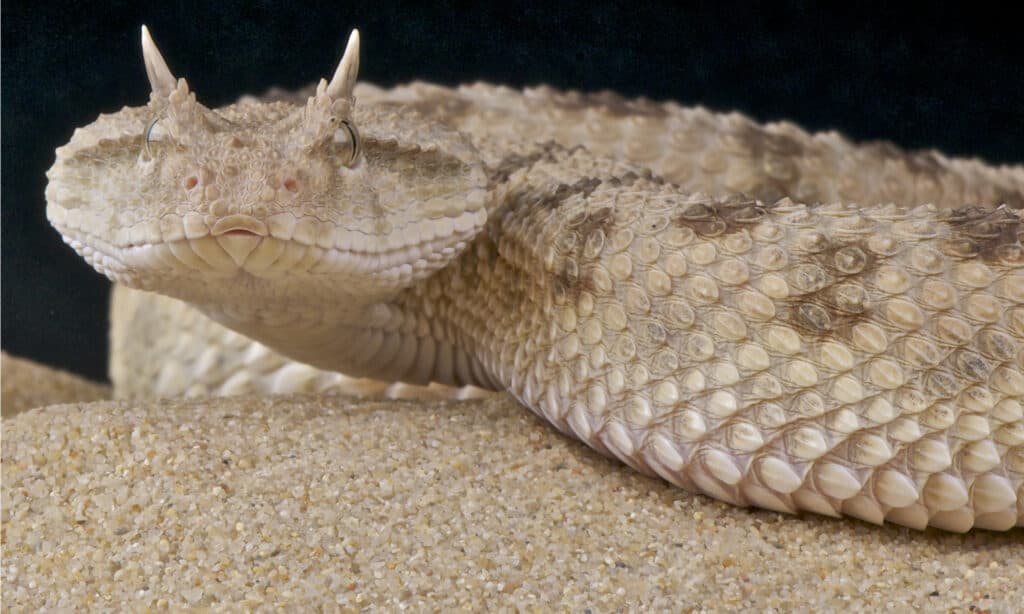
Desert horned vipers have heavy triangular heads with sand-colored bodies.
©reptiles4all/Shutterstock.com
The desert-horned viper gets its name from the horn-like scales above its eyes. They live in the deserts of North Africa and the Middle East. As members of the viper family, they’re highly venomous but grow only to a short three feet long. They have heavy, triangular heads with sand-colored bodies covered in darker brown bands.
3. Thornscrub Hook-Nose Snake
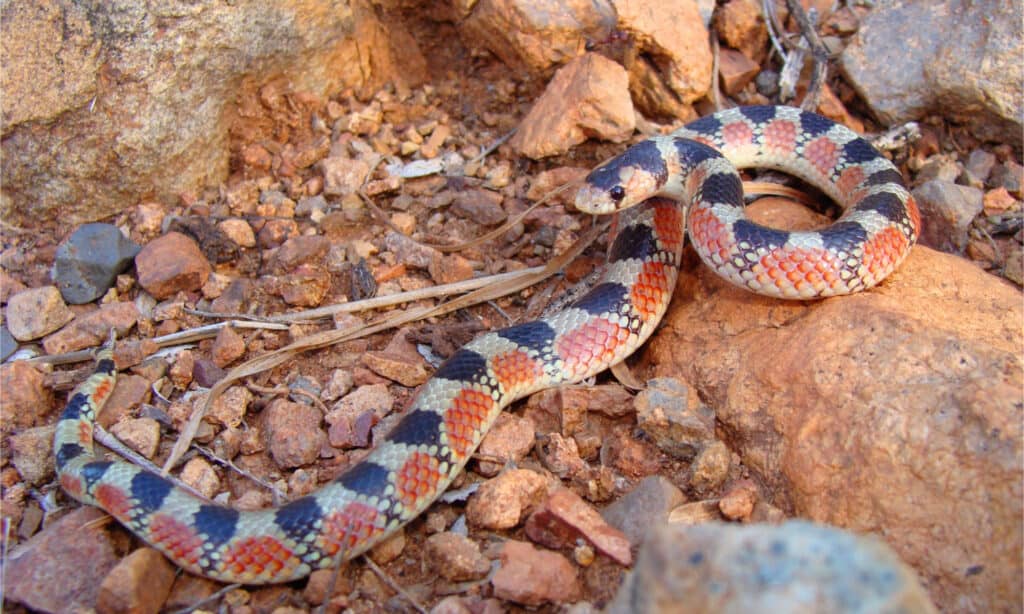
The thornscrub hook-nosed snake lives only in northern Mexico and southern Arizona.
©Matt Jeppson/Shutterstock.com
Though not well-known, these snakes are perhaps one of the most intricately colored and patterned of all snakes that live in the desert. They grow just over a foot long and have red, black, and white markings over their bodies. They live only in northern Mexico and southern Arizona.
2. Sidewinder Rattlesnake
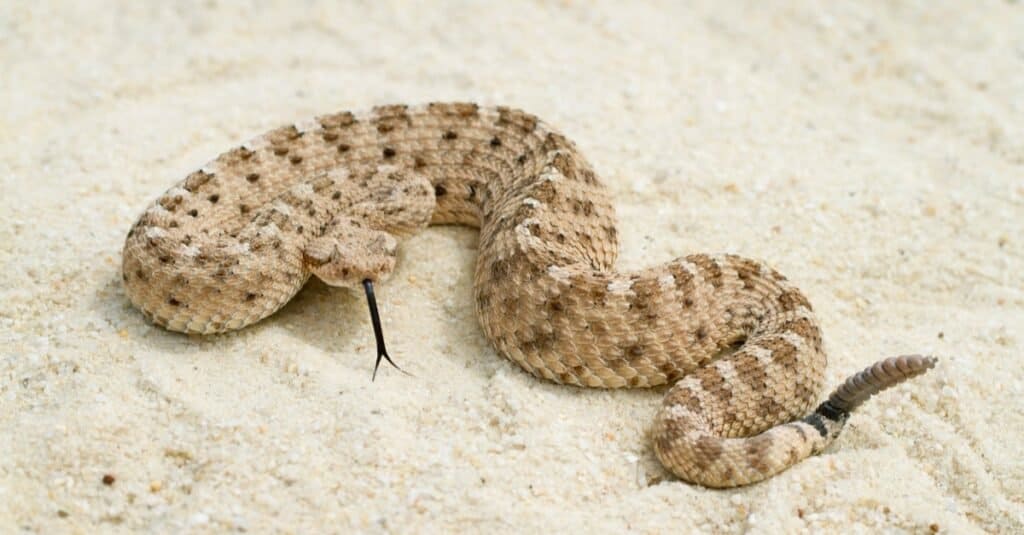
Venomous Sidewinder Rattlesnake (Crotalus cerastes) with forked tongue lying on the desert sand.
©Mark_Kostich/Shutterstock.com
The Sidewinder is one of the deadliest snakes that live in the desert. They’re common throughout the southwestern United States and northern Mexico. They can be distinguished from similar but less dangerous snakes by the presence of heat pits behind their nostrils, large fangs, and rattles.
1. Inland Taipan

The Inland Taipan is the most venomous snake in the world.
©reptiles4all/Shutterstock.com
Number one on our list of snakes that live in the desert is commonly known as the most venomous snake in the world. The inland taipan, despite its reputation and deadly bite, would much rather hide, or flee from humans, than bite. They live in the deserts of central and east Australia.
Inland taipans range in color from sand-colored to dark brown, depending on the time of year. They can grow to nearly six feet in length, making them one of the largest desert snakes on our list. Unlike some desert-dwelling snakes, the inland taipan eats only small to medium-sized mammals — no birds, reptiles, or amphibians.
Other Reptiles That Live in Deserts

There are plenty of lizards well-adapted to live in the hot, dry deserts.
©Ondrej Prosicky/Shutterstock.com
There are a variety of lizards that live in deserts. These include the side-blotched lizard, zebra-tailed lizard, desert iguana, chuckwalla, collared, and leopard lizards. The side-blotched lizard lives in the Sonoran and Mojave Deserts of North America. It is small, with three stripes running down each side of its body.
The zebra-tailed lizard can be found throughout the southwestern United States and into Mexico’s Baja California Peninsula. This species has a striped pattern along its tail which gives it its name, as well as dark bars across its back.
The desert iguana resides in parts of western America from California to Texas and southward through Mexico, where it inhabits dry areas such as creosote bush scrublands and sandy washes.
Chuckwallas are large lizards that inhabit rocky outcrops or valleys in Arizona, New Mexico, and Utah, while collared lizards occupy open woodlands near streams or rocky hillsides found throughout the south central US into northern Mexico. Lastly is the leopard lizard, which occupies arid regions like sagebrush flats located on both sides of the Sierra Nevada mountain range in California, extending into Oregon’s Great Basin region.
Other Animals Found in the Desert
In addition to snakes and lizards, there are many other amazing animals that make their homes in the desert.
One of the most iconic desert animals is the dromedary camel, dubbed “The Ship of the Desert” and built for the hottest and driest habitats thanks to its hump that is used to store fat and used for a food and water source when either are scarce. In cool weather, it’s possible for a camel to last as long as seven months without needing water.
The sand cat has also evolved to need little water as it gains the majority of hydration from its food, and can traverse the sands easily due to its dense paw pads supplying protection from the heat.
Another good example of an animal that has adapted for life in extreme heat it the saiga, a type of antelope known for its large snout that allows it to cool the air dispersed through its nose in the summer and to warm it up in colder temperatures.
One more desert-dwelling creature is the roadrunner. Made famous by Looney Tunes cartoons, this ground cuckoo is capable of reaching speeds of 20 miles per hour or even faster, and can fly away if needed. Find out more about these incredible desert animals here.
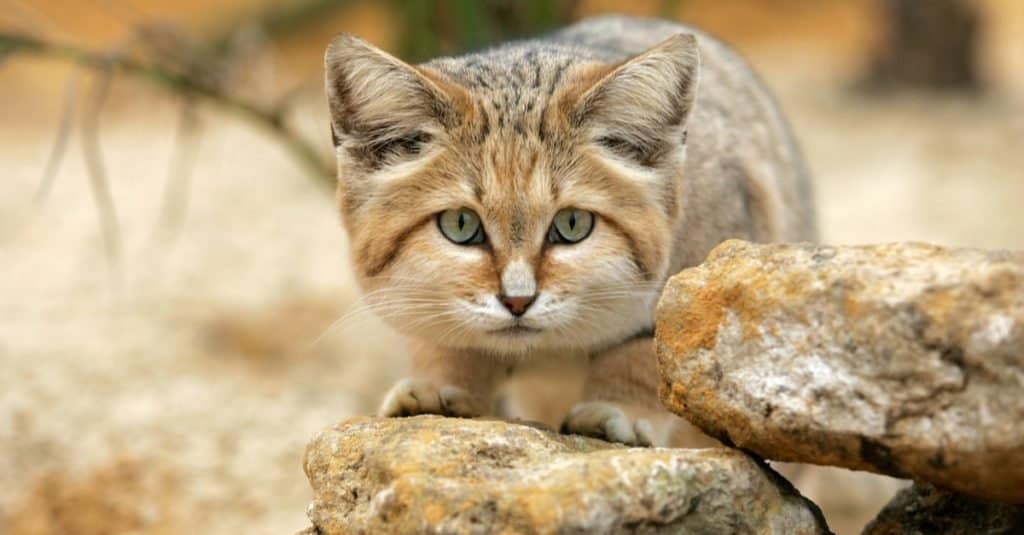
Sand cats have evolved for life in the desert and do not need much water at all.
©slowmotiongli/Shutterstock.com
Summary of the 10 Snakes That Live in the Desert
| Snake | Venomous | Location |
|---|---|---|
| 1. Inland Taipan | Yes | Queensland, Australia |
| 2. Sidewinder Rattlesnake | Yes | Southwest USA/Northern Mexico |
| 3. Thornscrub Hook-Nose Snake | No | Northern Mexico/Southern Arizona, USA |
| 4. Desert Horned Viper | Yes | Northern Africa/Middle East |
| 5. Sonoran Gopher Snake | No | Southwestern USA, Northern Mexico |
| 6. Mexican Short-tailed Snake | No | Mexico |
| 7. Horned Adder | Yes | Southwestern Africa |
| 8. Mulga Snake | Yes | Australia |
| 9. Western Diamondback Rattlesnake | Yes | Western North America |
| 10. Arizona Coral Snake | Yes | Arizona, USA |
The photo featured at the top of this post is © Ken Griffiths/Shutterstock.com
Discover the "Monster" Snake 5X Bigger than an Anaconda
Every day A-Z Animals sends out some of the most incredible facts in the world from our free newsletter. Want to discover the 10 most beautiful snakes in the world, a "snake island" where you're never more than 3 feet from danger, or a "monster" snake 5X larger than an anaconda? Then sign up right now and you'll start receiving our daily newsletter absolutely free.
Thank you for reading! Have some feedback for us? Contact the AZ Animals editorial team.






